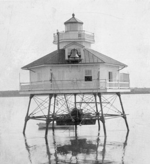Werowocomoco was a village that served as the headquarters of Chief Powhatan, a Virginia Algonquian political and spiritual leader when the English founded Jamestown in 1607. The name Werowocomoco comes from the Powhatan werowans (weroance), meaning "leader" in English; and komakah (-comoco), "settlement". The town was documented by English settlers in 1608 as located near the north bank of the York River in what is now Gloucester County. It was separated by that river and the narrow Virginia Peninsula from the English settlement of Jamestown, located on the James River.
Powhatan's Chimney at Wicomico, a site of historical ruins associated with a house purported to have been built for Powhatan, was long thought to have been the site of this capital. Its probable true site was tentatively identified by archaeologists in 2003 at a site on Purtan Bay, further west on the York River. Their survey and excavations revealed extensive artifacts, with habitation from the 13th into the 17th century. Its first settlement was dated about 1270 CE, with complex earthworks built about 1400 CE.
The area that the Native Americans considered Werowocomoco may have included both the newly identified Purtan Bay site and the site of Powhatan's Chimney site. The Gloucester County Board of Supervisors noted that in the Algonquian language the designation for the village of the chief was not a place name, but more correctly translated as a reference to the lands where he lived. The culture frequently relocated quarters within a general area.



